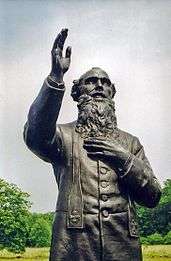William Corby
.jpg)
Father William Corby, CSC (October 2, 1833 – December 28, 1897) was an American priest of the Congregation of Holy Cross, and a Union Army chaplain in the American Civil War attached to the Irish Brigade. He later served twice as President of the University of Notre Dame.
Biography

He was born in Detroit, Michigan, to Daniel Corby, an Irish immigrant, and his wife Elizabeth, a Canadian. He attended public school until age 16, then joined his father's real estate business. In 1853, he enrolled in the 10-year-old College of Notre Dame in South Bend, Indiana, and began study for the priesthood three years later. Following ordination, he taught at Notre Dame, and served as a local parish priest.
Following his service in the Civil War, he returned to Notre Dame and served as its vice-president, 1865–66; and president, 1866–72 and 1877-81. His memoir of the Irish Brigade became a best-seller.
Irish Brigade
He is perhaps best known for giving general absolution to the Irish Brigade on the second day of the Battle of Gettysburg. Of the Brigade's original 3,000 men, only about 500 remained, and more than a third of them were killed or wounded in the battle. The scene of Fr. Corby blessing the troops was depicted in the 1891 painting Absolution under Fire by Paul Wood,[1] and dramatized in the 1993 film Gettysburg.
A statue by Samuel Murray – Father Corby, with right hand raised in the gesture of blessing – stands upon the same boulder on which the priest stood while blessing the troops that morning. It was the first statue of a non-general erected on the Gettysburg Battlefield, and was dedicated in 1910.[2]
He is widely remembered among military chaplains and celebrated by Irish-American fraternal organizations. Corby Hall at Notre Dame is named for him, and a copy of the Gettysburg statue stands outside the building. An organization of Notre Dame alumni is named The William Corby Society.[3]
See also
References
- ↑ "Rev. William Corby at Gettysburg". www.archives.nd.edu. University of Notre Dame Archives. 2 July 2013. Retrieved 26 February 2016.
Corby’s famous absolution has since been immortalized, among other places, in Paul Wood’s Absolution under Fire (1891) at the Snite Museum of Art and in statues on the Gettysburg Battlefield (1910) and on Notre Dame’s campus (1911).
- ↑ Father William Corby from Stone Sentinels.
- ↑ William Corby Society
Sources
- Bergen, Doris L. (ed.). The Sword of the Lord: Military Chaplains from the First to the Twenty-First Century. Notre Dame, IN: University of Notre Dame Press, 2004. ISBN 0-268-02175-9.
- Corby, Fr. William, CSC. Memoirs of Chaplain Life: Three Years with the Irish Brigade in the Army of the Potomac. Edited by Lawrence F. Kohl. New York: Fordham University Press, 1992. ISBN 0-8232-1251-3
External links
- Father William Corby from Irish Cultural Society of the Garden City Area.
- William Corby Archives from University of Notre Dame.
- William Corby at Find a Grave